Japanese Wolves – Part II: Yamainu
Posted by: Loren Coleman on June 16th, 2009
Japanese Wolves
Part II – Yamainu
by Brent Swancer
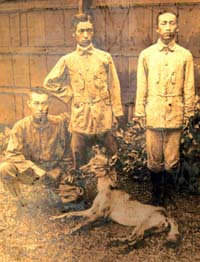
In the first installment of this Japanese wolf series, we looked at the Honshu wolf and the events leading to its supposed demise.

The date of extinction of the Honshu wolf has long been set at 1905, with the death of a specimen killed in Nara prefecture on Honshu island, Japan. Did the Honshu wolf survive past this date and thus defy the extinction orthodoxy?
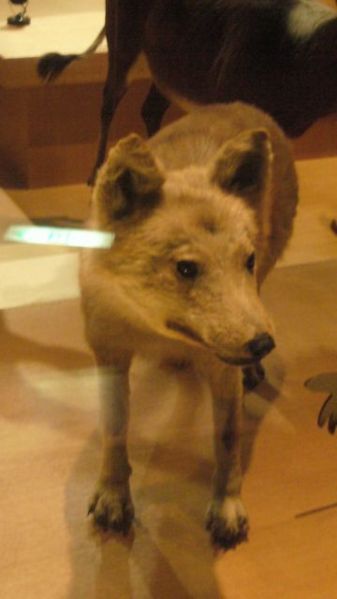
In August of 1910, five years after the death of the so-called “last one,” a strange canid was shot and killed at the Matsudaira agricultural station in Fukui prefecture. At first it was thought to be a feral dog or perhaps even an escaped Korean wolf from a zoo, but the following day zoo staff examined the carcass and refuted this, saying that the animal looked to be a presumably extinct Honshu wolf. This was a somewhat controversial stance, as many in Japan held firmly to the 1905 extinction date. Unfortunately, the preserved carcass of this specimen was destroyed in a fire during the years of the war and we were left with merely a photograph to go on.
For decades, the identity of the mysterious canid killed in 1910 was debated. There were many who disagreed with the analysis done by the zoo personnel, pointing to perceived differences between the photographed animal and the Honshu wolf. However in the early 2000s, Japanese zoologist and wolf expert Yoshinori Imaizumi, former head of animal studies at the National Science Museum, and his colleague Mizuko Yoshiyuki, also of the National Science Museum, did a thorough and detailed analysis of the photograph as well as journal entries made of the event at the agricultural station.
The two scientists came to the conclusion that the pictured animal was indeed a Honshu wolf. They argued that the physical characteristics of the pictured animal, such as its coloration, the rounded tail, and body dimensions all fit in with the Honshu wolf. The low body weight, which was recorded as 18.75 kg in a journal entry by personnel at the Matsudaira station, also fit in with Honshu wolves. It would appear that the extinction timeline should have been more thoroughly revised in light of these findings, yet debate continues and most widely available information still lists the Honshu wolf as becoming extinct in 1905.
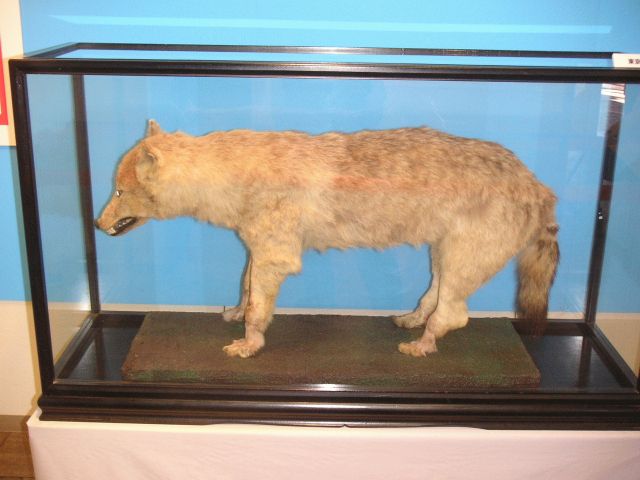
Is there a chance that the Honshu wolf survived until 1910? It certainly appears so. But what of the wolves’ survival beyond that? Could it have even perhaps survived into the present?
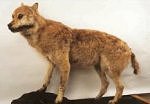
Over the years, sightings and circumstantial evidence have suggested this just may be the case. From the early 1900s all the way up until well into the 2000s, alleged Honshu wolf sightings, photos, and even reports of captures or carcasses have continued to pop up from time to time. Let’s look at a few standout cases, although this list is by no means comprehensive.
-In 1934 a group of foresters hunting deer claimed to have come across not one, but a whole pack of Honshu wolves, comprised of 5 or 6 individuals.
-In 1936, a villager on the Kii peninsula claimed to have actually captured a live wolf cub, however the man was reported to have released it back into the wild out of fear the mother wolf would come looking for it.
-The 1940s and 50s saw a sharp increase in wolf sightings. This spate of sightings is thought to be due in part to the huge conscription effort that was going on in Japan in the years around the war. Consequently, a large number of people were leaving the countryside during this time frame, which could have had led to a population boost for the wolves brought on by decreased hunting and increased populations of prey species.
-In 1964, a Mr. Kenji Yanai was mountaineering with his son and a co-worker near Ryogami Mountain when they heard a series of strange howls. Soon after, they came across a lone wolf, which is reported to have studied them for a moment before dashing into the forest, leaving its kill of a small hare behind in its escape.
– In 1966, a photograph was taken of an alleged Honshu wolf by a Hiroshi Yagi on a forest road in Saitama prefecture. The photo was inconclusive, and has been criticized as being a photo of nothing more than a dog.
– In the 70s, there was purportedly a carcass of an apparent Honshu wolf brought in to researchers for study. The body is said to have disappeared and it is unclear of what ever became of it or of any analysis done on it.
-Between the years of 1908 and 1978, Aomori and Oita prefectures were the source of at least 26 sighting reports of Honshu wolves.
-In 1998, there was a flap of mystery canid sightings in Chichibu, in the mountains not too far from Tokyo. On many occasions the mysterious canids were seen running through brush, across roads, through yards, and heard yipping or howling. One resident complained that a wolf-like animal had attempted to attack chickens he kept on his rural property.
– On July 8, 2000, a high school principal by the name of Satoshi Nishida photographed an alleged Honshu wolf in Kyushu while he was hiking. The animal photographed was a medium sized canine that was grey and white in color, with orange coloration on its legs as well as behind the ears. A series of photographs were snapped from 10 to 15 feet away before the animal disappeared into thick underbrush. I was unable to find images of these photos to post here, but they are of grainy quality and fairly inconclusive. Nevertheless, they were compelling to the previously mentioned Japanese zoologist and wolf expert, Yoshinori Imaizumi.
-In 2006, an eyewitness account was personally relayed to me by a Japanese woman who claimed to have seen two of the animals while hiking near her hometown in Wakayama prefecture. As she was hiking, the woman claimed to have heard a commotion coming from the brush to the side of the trail. The woman said that as she approached, she noticed two animals that she at first took to be Shiba dogs wrestling around in the bushes. However, on closer inspection, she came to the conclusion that something about them looked off, not quite like any type of dog she was familiar with. The animals seemed to be fighting over the carcass of some small animal, oblivious to her approach. When they noticed the woman, one of the canids darted away with the carcass and was quickly followed by the other.
Sightings are not the only evidence on offer. In many areas, alleged wolf tracks have been found, as well as purported wolf hairs and scat. Some shrines also claim to have pelts or other relics gathered from Honshu wolves that died after their supposed extinction date. For instance, in 1994 a shrine in Tottori prefecture was found to possess a wolf specimen that is thought to have possibly died as recently as the 1950s. An alleged wolf pelt was also found in the possession of a man who claimed it was killed sometime in the 70s, although this has not been confirmed.
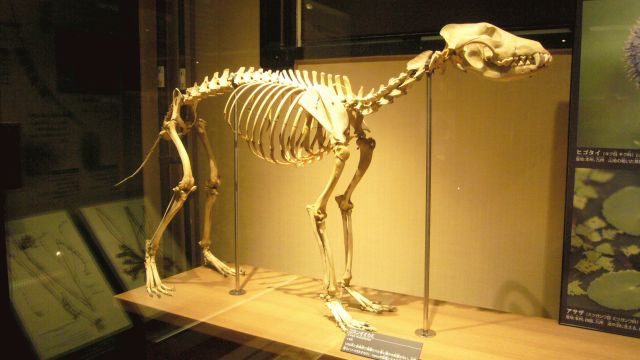
Occasionally wolf howls are reported as well. In 1994, for instance, at least 70 people reported wolf-like howls around the Kii peninsula, an area long considered a major hot spot for Honshu wolf sightings and activity.
So what is the chance that this evidence amounts to anything? Is it possible that Honshu wolves are still roaming the Japanese mountains?
The habitat in Japan is certainly able to sustain a population of wolves. The terrain is largely mountainous and forested, with the bulk of the human population concentrated into major urban centers on the coastal plains. Something like 90% of Japan’s population inhabits only around 10% of the actual land area. The forests abound with abundant prey species, to the point that animals such as deer and wild boar have become serious pests in many areas. The ecosystem would be quite comfortable for a predator such as the Honshu wolf. In fact, the wolf’s biological niche in Japan has never really been filled since its disappearance. Other Japanese predators are geared towards smaller prey, and even the closest thing to the wolves, the raccoon dog, or tanuki, does not prey on the same animals the wolves once did. The Honshu was a keystone predator and as such its apparent disappearance has had a negative effect on the Japanese ecosystem. Not only is the habitat in Japan suitable for sustaining the wolves, it sorely needs them.
It seems at least possible that considering the vast swaths of sparsely populated mountain wilderness, small populations could stay adequately hidden from people. While these areas are further encroached upon by urban centers, much of Japan’s wilderness remains remote and more and more people are moving away from rural areas to pursue a different life in the bustling cities.
Regardless of the potential for the habitat to support them, there are still certain problems that we are faced with when reviewing the evidence for the continued survival of the Honshu wolf. Physical evidence allegedly left behind by the wolves has so far been circumstantial at best. Tracks or scat could have been left by feral dogs or even domesticated ones that are allowed to roam. The dogs in many rural areas of Japan are often allowed to wander off into the forests at will, or live in an almost semi-feral state, which could result in canine tracks or droppings far out in the woods.
Attempts at DNA testing conducted on evidence such as hairs or preserved physical evidence have run into problems as well. Mitochondrial DNA testing has failed to clear up the identity of alleged wolf hairs, and DNA testing of preserved evidence such as scraps of pelts or bone have so far produced similarly inconclusive results. Furthermore, obtaining a good sample of Honshu wolf genetic material from the handful of known mounted specimens for comparison has presented its own challenge as the harsh chemicals used in the taxidermy process can produce faulty results. We simply don’t even have a completely reliable, solid sample of Honshu wolf genetic material with which to compare in the first place.
The problem is further compounded by the fact that some Japanese breeds of dog such as the Shiba inu, Akita inu, and Shikoku inu (note that “inu” simply means “dog” in Japanese), are thought to be possibly somewhat close, both phenotypically and genetically, to Honshu wolves. This is especially so if hybridization has occurred to any significant degree.
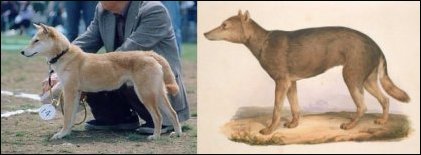
Jomon dog compared to Yamainu.
The “Pariah” dogs that followed human migrations to Japan during the Jomon period (approximately 8,000 to 200 B.C.), became the basis for most Japanese dog breeds. The Shiba inu, for example, is thought to have changed very little from the hunting dog early Jomon settlers brought with them.
It is thought that these Japanese breeds have possibly intermittently interbred with Honshu wolves over time to various degrees depending on who you ask. Intentional interbreeding is not so far fetched, as these early settlers certainly valued certain wolf-like characteristics in their dogs, such as hunting prowess and a strong family bond (pack mentality). Unintentional hybridizatrion also could have occurred.
This possible genetic similarity between Japanese dog breeds and Honshu wolf, combined with the already strong genetic plasticity of canines in general, potentially makes it difficult to conclusively prove anything through DNA results.
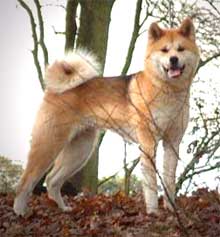
Akita inu.

Shiba inu.
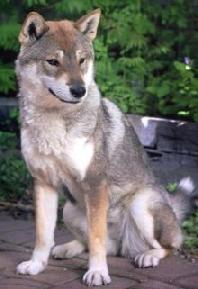
Shikoku inu.
Regardless of the specific genetic connections between Japanese dog breeds and the Honshu wolf, the clear physical similarities between them certainly could at least have an effect on the credibility of sightings reports. The Shiba inu in some ways look quite a bit like the Honshu wolf, as does the Shikoku inu breed and to a somewhat lesser extent the larger Akita inu. They could perhaps be mistaken for the wolves under the right conditions. Even in the clear photos I’ve provided here under ideal conditions, you can see the superficial resemblance between these dog breeds and the Honshu wolf is apparent. It isn’t too hard to imagine someone coming across a feral or wandering specimen of one of these dogs out in the middle of the woods or only fleetingly, and coming to the conclusion that they had seen a wolf.
Is it possible that all of the eyewitnesses are merely seeing dogs?
The reports of wolf howls are a bit harder to dismiss, yet there is the slight possibility that certain dog sounds could be mistaken as being from something like a wolf. The Shiba inu and some other Japanese breeds for example are known to produce high pitched noises and screams rather than barking or typical dog sounds. The Hokkaido inu breed also howls very much like a wolf. Could these have perhaps be misconstrued as “wolf noises” by a startled witness out in the woods? Most people are likely familiar with dog howls, though, and it doesn’t seem as if we would see quite so many wolf howl reports if they were all merely caused by dogs. There are no recordings of Honshu wolf vocalizations, so we are without a basis of comparison, however we are left with a compelling mystery. What is producing the howls that people are hearing and claiming to be those of wolves?

The timber or gray wolves (Canis lupus) of North America (above and below) are found in a variety of color forms. Could the same be true of Japanese wolves? And what overlap is there in their howls?

There have been attempts to further investigate these alleged wolf howls. In 1995, a team ventured into the wilderness of the Kii peninsula with recordings of howls from Canadian gray wolves with the intent to elicit howls in response from any Honshu wolves that may still be out there. After several nights of continuously playing the recordings, the team failed to get any answering howls at all. The following year, in 1996, a similar experiment was conducted in Saitama prefecture. The team made meticulous recordings of the forest sounds after regular blasting of grey wolf calls, yet close scrutiny of the tapes turned up no answering wolf howls. It would be interesting to see if further experiments of this kind turn up anything, but so far there has been nothing but silence.
Where are the Honshu wolves? Are they still out there prowling Japan’s wilderness, or have they been regulated to museums, Shinto wolf shrines, and legends? Do they still pierce the night with their howls, or are they forever quiet? If we continue to search, will we find wolves, or merely stories and anecdotes of a long vanished animal?
The mystery remains.
Stay tuned for the final installment of my Japanese Wolves series, as we discover that the Honshu wolf was not the only variety to inhabit Japan.
END
About Loren Coleman
Loren Coleman is one of the world’s leading cryptozoologists, some say “the” leading living cryptozoologist. Certainly, he is acknowledged as the current living American researcher and writer who has most popularized cryptozoology in the late 20th and early 21st centuries.
Starting his fieldwork and investigations in 1960, after traveling and trekking extensively in pursuit of cryptozoological mysteries, Coleman began writing to share his experiences in 1969. An honorary member of Ivan T. Sanderson’s Society for the Investigation of the Unexplained in the 1970s, Coleman has been bestowed with similar honorary memberships of the North Idaho College Cryptozoology Club in 1983, and in subsequent years, that of the British Columbia Scientific Cryptozoology Club, CryptoSafari International, and other international organizations. He was also a Life Member and Benefactor of the International Society of Cryptozoology (now-defunct).
Loren Coleman’s daily blog, as a member of the Cryptomundo Team, served as an ongoing avenue of communication for the ever-growing body of cryptozoo news from 2005 through 2013. He returned as an infrequent contributor beginning Halloween week of 2015.
Coleman is the founder in 2003, and current director of the International Cryptozoology Museum in Portland, Maine.

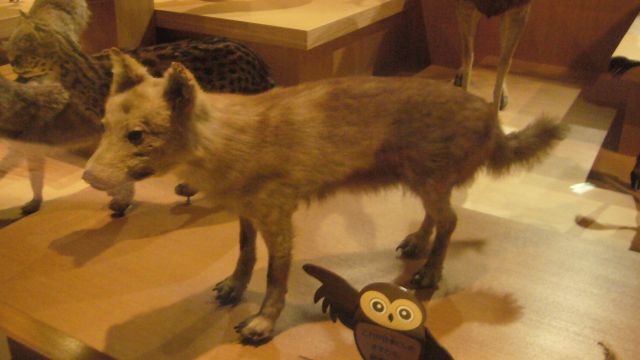









Cool. Lots of new info this time around.
Know what this sounds like to me? Eastern mountain lions, almost to a T. Everything that is theorized for a hypothetical survival to the present sounds almost identical.
While it may be more difficult for a social animal like the wolf to remain cryptic, it isn’t impossible. And canid behavior is quite plastic and adaptable to life outside the pack (look at the red wolf, which we’d forgotten was once a pack animal until it showed us again).
i wonder if they really howled at all. the only pack reference is the 1934 account after official extinction.
perhaps, the social stucture for the Honshu wolf was not as parallel to other wolf types. isn’t howling a form of long distance communication? maybe it wasn’t needed. could it be that the wolves traveled alone, in pairs, or small groups instead of larger, very socially complex packs like north american wolves? did they engage in cooperative and organized hunting? how much is known about these things?
too bad no good DNA is available. you know there is something preserved on a dusty old shelf somewhere!
Brent- just a bit of a side-note. A married couple, old friends of mine, had a pair of Akitas. One was not seen as properly socialized for company, but the other was convinced she was the biggest lap dog in the neighborhood.
American Akitas are so dissimilar from Japanese Akitas that the Japanese kennel club considers them separate breeds.
Wow Brent. These have been great so far. You know, I’m actually really struck by just how much the Shikoku resembles a wolf, right down to the snout coloration. We see the same patterns I guess in the Shiba and Akita pictured, but the size and curly tail of the Akita, and the dense fur and short legs of the Shiba, clearly mark them as having been bred for these characteristics, whereas the Shikoku, well… its just a REALLY beautiful, primitive looking dog.
Again, great articles. Can’t wait for part three.
maeko- That is a very good question, and one that is not completely understood. There is the possibility that they may not have howled in quite the same manner as gray wolves, but they did howl. I tend to think that since they evolved from Siberian wolves, and their habitat was rugged and mountainous, that they likely retained some howling behaviors for long distance communication. Ainu referred to the wolves of their land as the “Howling God,” so this indicates that at least the northern Hokkaido variety howled. (Wait for Part 3 for more on this. 🙂 ) Some Japanese folklore also refers to the wolf howls, and in some areas of Japan, the howls were thought to have a mystical quality. It seems that the Honshu wolves indeed howled to some extent.
We just don’t know how much they did this, or what their howls sounded like. There are no recordings with which to compare, so we can only speculate. It seems at least possible that the experiments with wolf howls may not be particularly effective due to the fact that they may be unlike gray wolf howls in some key way. I think the rationale behind choosing these was that Honshu wolves evolved from Siberian wolves, which are a subspecies of gray wolf, and therefore it was seen as possible the howls could overlap to some degree. However we don’t know for sure.
As far as hunting goes, they definitely were pack animals, and many accounts and folklore from the times when Honshu wolves were plentiful are tied to this. I think the sightings of lone wolves in later days is just testament to the extent of which their numbers had suffered. I also think that Honshu wolves could have exhibited lone hunting behaviors away from the pack when opportunities arose. Some wild canids do this, such as the Ethiopian wolf Canis simensis. They live in packs that defend and share a territory, yet they primarily hunt for small prey solitarily. So they display a curious mix of pack and solitary behaviors. Although Honshu wolves did hunt deer or boar in packs, perhaps they had some of these solitary behaviors similar to the Ethiopian wolves as well.
Anyway, hope this information is helpful.
Mystery_Man:
Not anything definitve but certainly “compelling” evidence.
Like I stated on the first post about this—I would not be surprised if the Honshu survived well into our times somewhere i the remote wilds of Dai Nippon.
Too bad about the destroyed carcass.
And the “howls” are very interesting as well.
Mystery_Man:
Do we know if these people who had the “canid” sightings were familiar with the Honshu??? Is it “popular” in the national imagination like, let’s say, the Kappa?
I don’t think playing gray wolf howling is going to get responses. don’t wolves eliminate competitors
when introduced to new areas?
I know the Akitas are a unique dog in the fact that they can retract their claws and can jump like a cat. Their folklore says that a feline and canine was mated to make the akitas. Oh, and don’t ever expect any akita to back up. They stand their ground, no matter what. They were primarily bred for bear hunting. Has anyone gone out with a Siberian wolf howl? Are we sure these wolves descended down from the Siberian wolf? Also, as far as the sound of their howl, don’t forget that there is a breed of dog that doesn’t bark…it has a high pitch yap, but no bark at all. I have heard some people calling it a short howl.
Some responses to questions and whatnot.
Jeremy_Wells- Thank you for the kind words. I am pleased that you are enjoying this series. I agree that the Shikoku inu is a very beautiful, very wolf-like dog. The Shiba inu pictured here is a bit on the heavy side and quite dark in coloration, but when they are thinner, they even more resemble Honshu wolves than the one pictured. The curled tail is something to consider, but these dogs will lower their tails when they like, or when they are curious or agitated. When they do this, the tail is remarkably similar to a Honshu wolf tail. You can see one in the comparative picture with its tail lowered.
cryptidsrus- The Honshu wolf is not really in the public imagination here. In fact, there is a surprising number of Japanese who are not even aware that they ever existed. Since there are only a handful of stuffed specimens and no photos of living ones, it is likely that even someone who knows wolves once existed in Japan may not be really sure of what they looked like. I’m not sure how familiar the all of the people who had these sightings were, but it is curious that they described something like what a Honshu wolf really looked like rather than what a gray wolf looks like. That is something I feel a person making up a report who didn’t know the appearance of a Honshu wolf would do. Of course it could also mean they just saw a dog. Anyway, I also would not be too surprised if there was a remnant population out there somewhere.
doorslinger- I think for the researchers, that’s besides the point. I think what they are trying to do is not necessarily get a friendly response, but rather any response at all. If they could get even aggressive howls in response, that would accomplish their main goal of collecting evidence for the Honshu wolves’ continued existence. I have my doubts about these experiments as well, but it is an interesting approach.
shumway10973- It is commonly accepted by zoologists that the two Japanese varieties of wolf descended from Siberian wolves.
The howls of Honshu wolves could have changed due to their isolation, but they still made noises close enough for them to be described as howls. As I mentioned in the article, a lot of Japanese dog breeds make screams and howling noises rather than barks. I guess some of their noises could be described as the “short howl” you describe, or something quite wolf-like.
Ceroill- Oh I can believe that. Dogs tend to have their own individual personalities just like us. 🙂 Same for wolves.
Oh, I forgot!
Kittenz- That is a very interesting piece of trivia about Akitas. Thank you! Although I must say that was an uncharacteristically short post for you on something about wolves and dogs. I expected you to jump right in there. 😉
Doorsliger- I do admit that perhaps any Honshu wolves out there could be frightened by these wolf calls blasting away, and perhaps are not inclined to answer even if they are similar. I certainly think the silence in response is not necessarily indicative that no Honshu wolves remain. As far as I know, though, there are actually further plans to pursue this approach. I’m not sure how effective this is going to be, but I’ll be keeping an eye out for anything they turn up.
shumway10973,
Akitas cannot retract their claws nor jump like cats. I speak from personal experience, having had one from the age of 8 weeks until his death at 8 1/2 years, and having rescued and fostered several others.
m_m,
I don’t have time right now to respond as thoroughly as I want, but when I catch a breather I intend to dive in. I really enjoy your posts; these are terrific!
thanks mystery man!
Great post. The possibility of a species surviving past the official extinction date is fascinating. There seems to be good evidence that the Tasmanian tiger survived into the 1950’s, so it isn’t completely outlandish to think that the Honshu wolf could also have survived several decades past 1905.